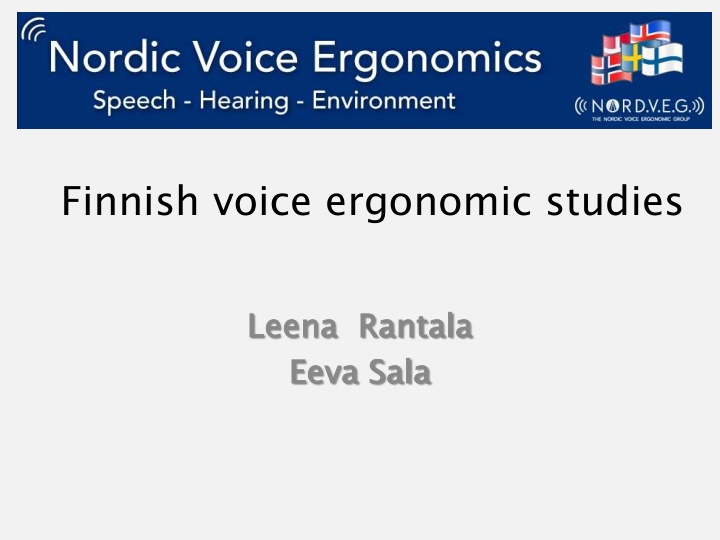



Finnish voice ergonomic studies Le Leena na R Ran antala tala Eeva va Sal ala
Surveys, Laboratory study, Field studies, Rehabilitation study (coming)
Surveys • Several studies • Aims e.g. – Voice symptoms and voice related disorders – Working culture – Genetic vs. environmental origin • Participants: – teachers – nursery school teachers – teacher students
Laboratory study
Laboratory study: voice loading • Pa Part rticip icipants nts – 40 males and 40 females – Normal speakers • Lo Loading ding – 5 x 45 minutes + 2 rest periods – Differ fferent ent condi ditions tions: • Sound pressure levels: ’conversation’ level and loud • Postures: sitting and standing • Indoor air humidity: dry and humid
Field studies
Field study: loading changes • 2 studies for female teachers • 33 and 79 participants • Voice symptoms and phoniatric examination • Voice production – Recordings » teaching speech (during lessons) » text reading, prolonged phonation (outside lessons) • 1 study for male teachers • 22 participants • 1 study for call centre advisers • 24 females, 8 males • 4 recordings during a workday
Voice ergonomics in workplaces
Study: Voice ergonomic assessment • 2 studies: nursery schools and schools • Voice risk factors assessed – (1) noise, (2) indoor air quality, (3) working postures, (4) working culture (included stress) and (5) a lack of using sound amplifier • Voice symptoms • Voice use – during work – before and after a working day
Coming
Voice therapy: carrying voice ergonomics/good vocal habits into teaching culture • Female teachers – 30 voice therapy with special emphasis on carry over – Controls • 30 with ‘traditional voice therapy’ • 30 without therapy • 2 year follow up
What do we know now? Results
Voice symptoms Environmental factors effect more than genetic ones • Voice disorders have increased during last years • Allergy is more typical in those with voice symptoms • Occupational health care does not know how to treat • voice disorders Teachers: • – 42 - 29 % symptoms frequently Nursery school teachers: • – 71 % symptoms frequently, 11 % organic changes in the larynx Teachers student • – 20 % voice symptoms, 19 % organic changes in the larynx
Voice loading • Voice symptoms arise • Voice rest – helps to recover (laboratory study) – the effects of voice risk factors are found in the morning (field study)
Voice loading effects • Voice production changes – Increase of • F0 (pitch) and SPL (loudness) • effort to produce voice (change of glottal pulse) • hyperfunctional voice quality (spectrum levels) – Decrease of • Perturbation (jitter and shimmer) increases in vocal fold vibration
Voice ergonomics in work places • Nursery school – have high background noise levels – 17 % of the rooms in day care centre had adequate room acoustics (measured by RASTI) • Nursery school teachers vs. nurses – talk longer (40 % of the working time) than nurses (28 %) – talk louder (78 dB) than nurses (72 dB) • Many voice ergonomic risk factors in the classrooms
Voice ergonomics and voice health Teachers – The more voice ergonomic risk factors in the classroom • more voice symptoms • higher SPL (voice loudness) before and after a workday – Poorer indoor air quality, more laryngitis
Carry over study: preliminary results • 8 teacher with carry over method/ 5 traditional – Both therapies affect • Voice quality towards more economical voice production (perceptual evaluation) • Subjective evaluation (VAS-scale): less voice tiredness – ½ yr after therapy: more constant results with carry over method
Recommend
More recommend